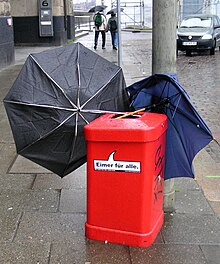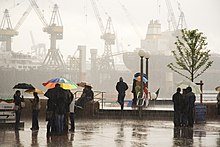Bad weather
Bad weather is particularly in northern Germany the term for a weather situation with weak winds with high air pressure , low cloud cover and drizzle or drizzle . The term goes back to the Low German word smuddeln , which means “unclean to work”. In relation to the weather, the pollution caused by persistent wetness through mud and mud is illustrated.
Dirty weather usually occurs in autumn , but is possible at any time of the year and at different temperatures , but is usually perceived as wet and cold . That such conditions most time in Hamburg is, is as Hamburger foul weather while literally - "the weather was bad in the one half of the year, while it is raining in another time" - but not proven. The Hamburg climate is determined by the maritime influence, which is particularly noticeable in the relatively frequent light to stiff breezes . In the interplay of this wind with the rapid warming of built-up and sealed surfaces and the rapid runoff of rainwater, however, heat islands form faster over the urban area than in its surroundings. This leads to an average high rainfall of 770.3 liters per square meter annually and about 200 rainy days. This puts Hamburg in the upper range of the statistics for the rainiest cities in Germany, but not at the top.
Different weather conditions can also be determined within the urban area of 755 square kilometers . For example, the temperature in the inner-city area between the Alster and Elbe is the warmest part of the city due to the dense development and the associated increased heat radiation , on average four to five degrees higher than in the peripheral areas. And while in the entire northeast of the city and in the Harburg mountains with up to 800 liters per square meter more rain is measured than in the rest of Hamburg, Bergedorf and Kirchwerder in the southeast with 600 to 650 liters are significantly drier districts. The German Weather Service notes that the wind mostly drives the moisture in from the southwest, which is carried by the warm air currents rising above the city into cooler layers of air , where it condenses and finally rains down over the northeast of the city. Part of the moisture is previously deposited on the Harburg mountains as a natural barrier. However, since large areas of water only heat up slowly, the upward current over the Elbe is much lower, so that rainfalls are often not transported further over this weather divide.
Web links
- Time online from August 19, 2004: Sunny South , accessed on March 23, 2012
- NDR commercial: Das Beste am Norden , accessed on March 23, 2012
Individual evidence
- ^ Michael Richey: Idioticon Hamburgense or word book to explain the own, in and around Hamburg common Lower Saxon mouth art , reprint of the edition of 1755, Kötz Verlag, Hamburg 1975, p. 269; also as google book
- ↑ Duden online: Bad weather
- ^ Franklin Kopitzsch , Daniel Tilgner (ed.): Hamburg Lexikon. 3rd, updated edition. Ellert & Richter, Hamburg 2005, ISBN 3-8319-0179-1 , p. 606.
- ^ Franklin Kopitzsch, Daniel Tilgner (ed.): Hamburg Lexikon. 3rd, updated edition. Ellert & Richter, Hamburg 2005, ISBN 3-8319-0179-1 , p. 395.
- ↑ Statista: Cities in Germany with the most rainy days in 2004 , accessed on March 23, 2012
- ↑ Welt online: The Hamburg weather does not exist , article from October 28, 2001 , accessed on March 23, 2012

